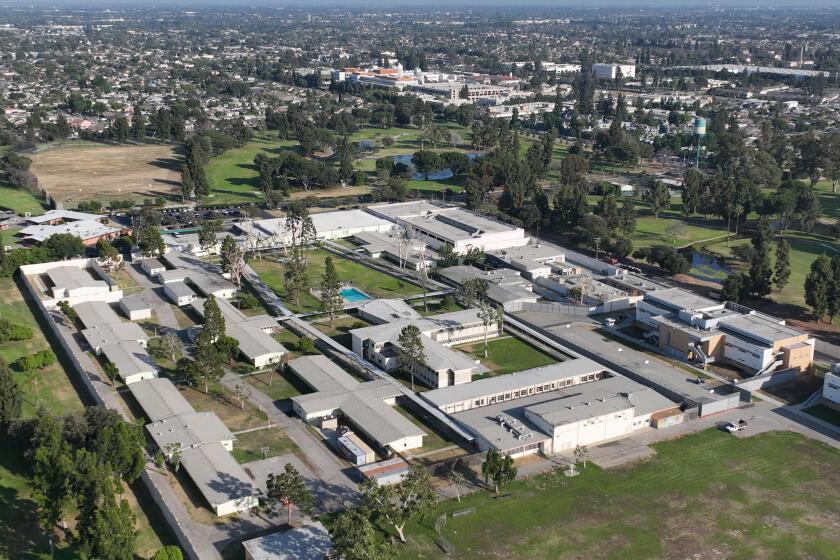Mayor Karen Bass’ unfavorable ratings spiked following fires, survey shows

- Share via
Los Angeles Mayor Karen Bass is significantly less popular than she was a year ago, likely because of her handling of January’s devastating fires, according to a new survey by the UCLA Luskin School of Public Affairs.
The survey of Los Angeles County residents found that Bass’ unfavorable ratings had shot up by 17 percentage points compared with a year ago.
For the record:
11:21 a.m. April 16, 2025An earlier version of this story said the survey by the UCLA Luskin School of Public Affairs was of Los Angeles residents. It was of Los Angeles County residents.
Nearly half of the county residents polled had unfavorable views of Bass, compared with 32% last year. At her highest levels of popularity in 2023, a few months after she was elected, she was viewed 46% favorably and 23% unfavorably.
In this year’s survey, taken between Feb. 23 and March 9, 37% of residents had a favorable opinion of Bass, compared to 42% last year.
While the poll did not ask whether the fires factored into residents’ views of Bass, her drop in popularity was probably related, said Zev Yaroslavsky, a former City Council member and L.A. County supervisor who runs the Los Angeles Initiative at Luskin.
“Bass has taken the brunt of the criticism over the fires. That’s the bad news. The good news for her is this happened overnight, and she has an opportunity to, by performing well in recovery, win back people she has lost,” Yaroslavsky said.
Some of the 1,400 residents polled live outside L.A. city limits and will not be eligible to vote for mayor when Bass faces reelection in 2026. She is already facing a recall attempt, though it will be a steep climb for organizers to collect enough signatures to force a vote.
Bass also performed poorly in another major poll since the fires. Less than 20% of respondents to a UC Berkeley Institute of Governmental Studies poll, co-sponsored by The Times and released in March, said she did an excellent or a good job in responding to the fires. More than 40% said she did a poor or very poor job.
Bass has defended her leadership during the crisis, citing the speed of issuing city building permits for homes damaged in the Palisades fire and the quick restoration of water and power compared to other California blazes.
“The Mayor is focused on leading what is on track to be the fastest disaster recovery effort in California history,” Zach Seidl, a spokesperson for Bass, said in a statement.
A little over 40% of L.A. voters said Mayor Bass did a poor or very poor job in responding to the fires, while just 19% saw her response as excellent or good.
The polls follow Bass’ rocky performance in the wake of the fires. She was in Ghana when the fires broke out, despite warnings of dangerously high Santa Ana winds. She traded barbs with her fire chief, Kristin Crowley, eventually removing Crowley after saying the chief failed to warn her about the concerning weather forecasts.
The Luskin survey took the pulse of L.A. County residents on many other issues, but the main storyline of this year was the fires, said Yaroslavsky.
More than 40% of respondents said they knew someone personally affected by the Palisades and Eaton fires, which killed at least 30 people and scorched thousands of homes in Pacific Palisades, Altadena and surrounding areas.
More than a quarter of people surveyed said they had lost some income because of the fires.
In one nearly unanimous category, 89% of respondents said that those who lost their properties in the fires should be allowed to rebuild at the same location.
Mayor Karen Bass’ texts illustrate how she communicated remotely with her staff and across levels of government, trying to marshal federal resources as the conflagration exploded. They also show an Angeleno desperate to get home.
The survey pointed to changes on some other fronts as well, including homelessness, which was Bass’ signature issue before the fires.
For several years, the percentage of L.A. County residents who believed that homelessness was getting worse had gone up. But in 2025, the percentage declined 8%, from 60% in 2024 to 52% this year.
Still, only 10% of residents think the homeless situation is improving.
The number of “unsheltered” homeless — people living on the street — in Los Angeles County fell by about 5% from 2023 to 2024 after years of increases, according to the annual count by the Los Angeles Homeless Services Authority.
More to Read
Sign up for Essential California
The most important California stories and recommendations in your inbox every morning.
You may occasionally receive promotional content from the Los Angeles Times.













